 Since the end of the 19th century, Indian summer monsoon rainfall (ISMR) predictions have improved. However, prediction skill of the operational forecasts from 1989-2012 is quite low. Variations as small as 10% in the All-India Rainfall Index (AIRI), used by the Indian Meteorological Department (IMD) to measure the ISMR, can lead to intense flooding or drought impacting Indian communities and the economy. Accurate and well-timed forecasts of AIRI are important for adaptation and mitigation planning.
Since the end of the 19th century, Indian summer monsoon rainfall (ISMR) predictions have improved. However, prediction skill of the operational forecasts from 1989-2012 is quite low. Variations as small as 10% in the All-India Rainfall Index (AIRI), used by the Indian Meteorological Department (IMD) to measure the ISMR, can lead to intense flooding or drought impacting Indian communities and the economy. Accurate and well-timed forecasts of AIRI are important for adaptation and mitigation planning.
A new paper published in Nature Communications, from research supported by CPO’s Modeling, Analysis, Predictions, and Projections (MAPP) program, indicates that the low skill of the operational models over the past two decades is due to missed new sources of predictability that have surfaced during recent global warming.
These new predictors include the development of the so-called Central-Pacific ENSO, the deepening of the anomalous Asian Low, and the strengthening of North and South Pacific Highs during boreal Spring. Including these new predictors in a physical-empirical model produced a much higher prediction skill compared to the current operational forecasts.
Access the paper at: http://www.nature.com/ncomms/2015/150518/ncomms8154/full/ncomms8154.html
Wang, B. et al. 2015. Rethinking Indian monsoon rainfall prediction in the context of recent global warming. Nat. Commun. 6:7154 doi: 10.1038/ncomms8154.



